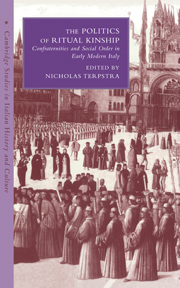Book contents
- Frontmatter
- Contents
- List of Contributors
- Acknowledgments
- Introduction The Politics of Ritual Kinship
- 1 The development of confraternity studies over the past thirty years
- 2 Homosociality and civic (dis)order in late medieval Italian confraternities
- 3 Confraternities and lay female religiosity in late medieval and Renaissance Umbria
- 4 The bounds of community: commune, parish, confraternity, and charity at the dawn of a new era in Cortona
- 5 Men and women in Roman confraternities in the fifteenth and sixteenth centuries: roles, functions, expectations
- 6 The Medici and the youth Confraternity of the Purification of the Virgin, 1434–1506
- 7 In loco parentis: confraternities and abandoned children in Florence and Bologna
- 8 The first Jesuit confraternities and marginalized groups in sixteenth-century Rome
- 9 Jewish confraternal piety in sixteenth-century Ferrara: continuity and change
- 10 The scuole piccole of Venice: formations and transformations
- 11 Relaunching confraternities in the Tridentine era: shaping conscience and Christianizing society in Milan and Lombardy
- 12 The development of Jesuit confraternity activity in the Kingdom of Naples in the sixteenth and seventeenth centuries
- 13 Corpus Domini: ritual metamorphoses and social changes in sixteenth- and seventeenth-century Genoa
- 14 Faith's boundaries: ritual and territory in rural Piedmont in the early modern period
- 15 The suppression of confraternities in Enlightenment Florence
- Bibliography
- Index
- CAMBRIDGE STUDIES IN ITALIAN HISTORY AND CULTURE
13 - Corpus Domini: ritual metamorphoses and social changes in sixteenth- and seventeenth-century Genoa
Published online by Cambridge University Press: 02 October 2009
- Frontmatter
- Contents
- List of Contributors
- Acknowledgments
- Introduction The Politics of Ritual Kinship
- 1 The development of confraternity studies over the past thirty years
- 2 Homosociality and civic (dis)order in late medieval Italian confraternities
- 3 Confraternities and lay female religiosity in late medieval and Renaissance Umbria
- 4 The bounds of community: commune, parish, confraternity, and charity at the dawn of a new era in Cortona
- 5 Men and women in Roman confraternities in the fifteenth and sixteenth centuries: roles, functions, expectations
- 6 The Medici and the youth Confraternity of the Purification of the Virgin, 1434–1506
- 7 In loco parentis: confraternities and abandoned children in Florence and Bologna
- 8 The first Jesuit confraternities and marginalized groups in sixteenth-century Rome
- 9 Jewish confraternal piety in sixteenth-century Ferrara: continuity and change
- 10 The scuole piccole of Venice: formations and transformations
- 11 Relaunching confraternities in the Tridentine era: shaping conscience and Christianizing society in Milan and Lombardy
- 12 The development of Jesuit confraternity activity in the Kingdom of Naples in the sixteenth and seventeenth centuries
- 13 Corpus Domini: ritual metamorphoses and social changes in sixteenth- and seventeenth-century Genoa
- 14 Faith's boundaries: ritual and territory in rural Piedmont in the early modern period
- 15 The suppression of confraternities in Enlightenment Florence
- Bibliography
- Index
- CAMBRIDGE STUDIES IN ITALIAN HISTORY AND CULTURE
Summary
The Genoese staged civic-religious processions in celebration of two eucharistic feasts: the first took place on Holy Thursday and the second on the feast day of Corpus Domini. On Holy Thursday, a number of confraternal processions made their way towards the cathedral of San Lorenzo where the sepulchre which housed the Holy Sacrament was to be found, but on Corpus Domini only a single procession carried the Eucharist in triumph through the city, one in which confraternities had a secondary role. The liturgical reforms which were introduced in the wake of Vatican II modified the feast of Corpus Domini since it was regarded as a mere replica of Holy Thursday. During the middle ages, however, so many rituals and services marked Holy Thursday (the Reconciliation of Penitents, the Blessing of the Holy Oils, the Pedilavium), that a new liturgical feast day was created in order to celebrate the Eucharist with greater and more appropriate ceremony: this was the argument of Urban IV's 1264 bull Transiturus de mundo which promulgated the celebration of Corpus Domini throughout Christendom after its beginnings in the diocese of Liège. This article will trace the development of the two feasts, and seek to demonstrate how the evolution of religious norms, political institutions, and the brotherhoods themselves made confraternities central to the public celebration of one feast, while they had no influence on the other.
Despite the fact that it was not originally part of the liturgical office for the day, the procession became, in the course of the fourteenth century, the distinguishing event of Corpus Domini, and for many cities in western Europe the most important religious and civic occasion of the year.
- Type
- Chapter
- Information
- The Politics of Ritual KinshipConfraternities and Social Order in Early Modern Italy, pp. 228 - 242Publisher: Cambridge University PressPrint publication year: 1999
- 1
- Cited by



